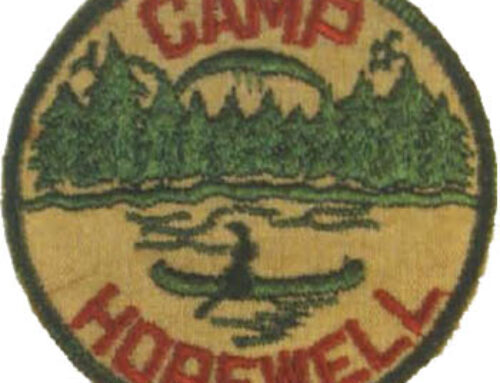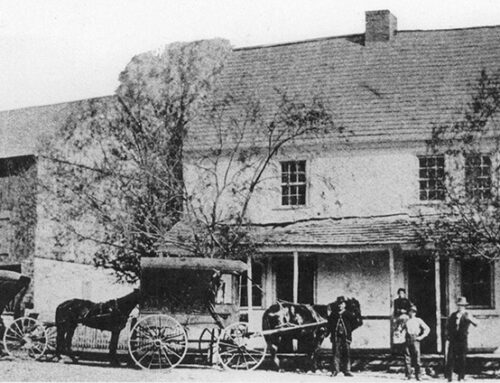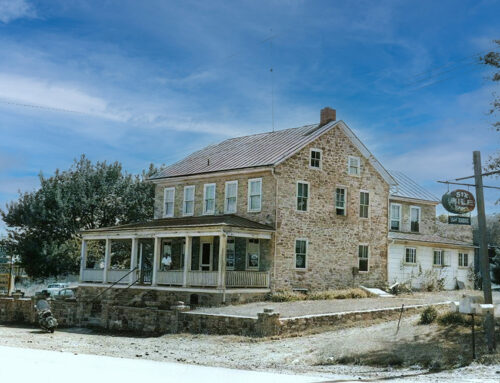Anyone traveling into West Reading across the Penn Street Viaduct has probably noticed at one time or another the large rock formation on the right against the exit ramp for motorists traveling West on the By-Pass into West Reading. The rock formation is known as Leinbach’s Hill although some people call it Yeager’s Hill or even Fred’s Hill. The hill used to be part of a farm of 116 acres situated along the Schuylkill River, to the west of Reading, which came to be called West Reading. In 1864 Frederick R. Frill purchased the farm which at the time was owned by the Leinbach family and before that the Bell family. A map from 1876 shows the land owned by Frederick Frill.

At that time, the entire hill, extending from the Penn Street Viaduct to the one carrying the tracks of the Lebanon Valley railroad, a distance of more than half a mile, was covered with grand old trees that made an avenue of shade almost the entire length, and on any fine Sunday in summer, it would invariably be visited by scores of people. The hill was a favorite place for a stroll especially for those of the lower section of the city. The first wild flowers of the season, such as trailing arbutus, wild honeysuckle and columbine, could invariably be found on the hill. From its top a fine view of the city could be obtained and a canal running the entire length of its base, added greatly to its beauty and afforded opportunity for bathing. The hill in present-day West Reading was destroyed by quarrying and in the construction of the West Shore Bypass.
For decades, the loudest noise to be heard in Reading was the firing of a cannon on the Fourth of July and special occasions, a time honored habit that was in vogue for many years. The cannon sat on the highest point on Leinbach’s Hill atop a limestone quarry high above the north side of the present Penn Street Viaduct for about a century-from the late 1700s to the late 1800s.
Below: An 1881 rendering by J. Hanold Kendall (shown below) depicts the cannon in the foreground being fired from Leinbach’s Hill. The firing of a canon was relatively common during much of the 19th century to signal the New Year and celebrate the Fourth of July.

The cannon on Leinbach’s Hill was removed prior to excavation for the deep cut created for the Belt Line R.R.’s passage through West Reading in 1902.
Below: In 1912, the cannon was moved to the Keystone Fire Company’s summer home at Glenside, along the east side of the Tulpehocken Creek. The building is now known as the Veteran Firemen’s Association Bungalow at 1427 Montgomery Street, in the Glenside section of Reading. The cannon can still be viewed at this location.

About 1870, while the projected South Mountain railroad was being extended from Strausstown by way of Bernville to a point opposite Reading, a quarry was opened by Frederick Frill at Leinbach’s Hill, adjoining the west end of the Penn street bridge. The depth from the summit to the bottom of the quarry was 104 feet. The stone was quarried in as large sizes as possible, the large stone supplied to the Berks County Railroads for the abutments of bridges. Some of the stone weighed as much as seven tons. The smaller stone were broken up into convenient sizes for building stone. The stone fragments were supplied to the city for the macadamizing of streets.
Different parties operated the quarry and a crusher to supply crushed stone with more or less success for upward of thirty years, when the property was leased from the owner, Rev. George Bornemann of St. Paul’s R.C. Church, Reading, P.A, by the McQuade Brothers (James P. and Michael), of Pottstown, in 1906. The McQuade Brothers substituted a larger and more improved crusher with a daily capacity of six hundred tons. Most of their product was supplied to the city of Reading.
The McQuade Brothers quarry operations at Leinbach’s Hill were extensive. The tract extended to the Belt Line and Lebanon Valley railroads and covered hundreds of acres. In the first several years that they conducted operations it was estimated that they disposed of about 225,000 tons of different sizes of crushed rock. In 1908, a member of the firm estimated that space of 300 feet long, 150 feet wide and 65 feet high, had already been removed equating to 124,583 tons of stone. Quarrying operations continued into the 1920s until Leinbach’s Hill was purchased by Berks County industrialists and philanthropists Ferdinand Thun and Henry Janssen.
Below: McQuade Brothers quarry (left side of photo) facing Reading and 1884 Penn Street Iron Bridge.

Below: 1897 photo of the Penn Street Iron Bridge looking towards Reading. The limestone formation at the left foreground was part of Leinbach’s Hill where quarrying operations had been conducted for many years.

Below: Photo of the second Penn Street Covered Bridge, looking toward Leinbach’s Hill in West Reading, during dismantling in 1884 for the erection of the Iron Bridge. The three-span, two-lane, 600-foot-long bridge was built in 1851 at a cost of $17,000 after the Great Flood of 1850 destroyed the first Penn Street Covered Bride. The Iron Bridge, erected at a cost of $120,000, was replaced in 1913 by the present Penn Street Viaduct.

In October 1928, Ferdinand Thun and Henry Janssen offered to donate Leinbach’s Hill in West Reading, real estate valued at $115,000, and another $85,000 to beautify the surroundings, for the erection of a new court house. There was a hitch, however, Reading was (and still is) the county seat and Leinbach’s Hill was in the borough of West Reading. As a third-class city, Reading would have had to annex the whole of West Reading for the location to be accepted.
Surprisingly, on May 29, 1929, Burgess Harry Good and other borough officials of West Reading appeared before city council with a proposal for annexation. Reading’s “city fathers” took a dim view of the arrangement – in part, allegedly, at the bidding of certain barristers who foresaw great personal inconvenience in commuting from their center-city offices to a cross-the-river site. Thus, the generous offer from Thun and Janssen and the prospect of a new Court House at Leinbach’s Hill, magnificently landscaped, were laid to rest.
In 1955, several of West Reading’s oldest properties were threatened with demolition when the state unveiled a plan to build a cloverleaf on the west end of the Penn Street bridge for a bypass between Mount Penn and the Warren Street Bypass.
In 1956, plans were completed for linking the Warren Street Bypass to the north of Reading with the Philadelphia Pike east of Mount Penn. The super-road was depicted as a substantial contribution to the economic welfare of central Berks County, not to mention its role as a vital element in resolving the multiplying problems of traffic congestion in the central business section of the city.
Plans included the removal of much of Leinbach’s Hill and buildings and businesses located in the 100 block of Penn Ave. The following is a list of some of the businesses that were removed: Laurel Hosiery Co, Inc., 1 Penn Ave.; Wayne Potteiger’s Gulf service station at 15 Penn Ave.; Walter G. Eberl’s Memorial Arts Studio, monument works, 17 Penn Ave.; Keiser Manufacturing Co., 20 Penn Ave.; B.J. Smith Furniture and Showroom, 21 Penn Ave; Hen Johnston, Inc, 40 Penn Ave.; Pear & Co. scrap yard at the rear of 40 Penn Ave.; service station at 46 Penn Ave.; Atlantic Refining Co. regional office, 64 Penn Ave.; F. R. Turner’s Esso service station at 107 Penn Ave.; Royalton Knitting Co., 123 Penn Ave., Berklan Roofing and Sheet Metal, 133 Penn Ave.
Below: 1929 aerial view of Leinbach’s Hill and the 100 block of Penn Avenue, West Reading (bottom of photo).

Below: Some of the businesses on the North side of the 100 block of Penn Avenue which were removed for the construction of the By-Pass.


Below is a photo showing the stone quarry remains in the 1950s. In the foreground is what remained of Leinbach’s Hill prior to construction of the West Shore By-Pass and the cloverleafs at the west end of the Penn Street Viaduct. Near the right side of the photo, on the south side of Penn Ave., is the low-lying elongated plant where Keiser Manufacturing Co., headed by David Keiser of Wyomissing Hills, produced the finest sheers in the world. Towering above the Keiser factory are massive buildings that comprised the Wertz Warehouse complex. The factory with the string of skylights, perpendicular with the west end of the Viaduct, was built as a hosiery mill. On the lower left is a path leading into the rocks. Just out of view was a steep incline, maybe 18 feet, to the entrance of “the West Reading Cave,” which was a true limestone cave. The path to the cave branched off the “old River Road,” partly visible, which led from Penn Avenue, back along the Schuylkill, to Bushong’s Covered Bridge near Glenside. Today’s West Shore By-Pass runs right over the top of old River Road, but at a higher elevation.

In August, 1962, construction crews started blasting away at Leinbach’s Hill. Dynamite was used to chip it away with a lot of little booms instead of tremendous blasts that would have wrought havoc on surrounding properties. The thunder men timed series of small charges about one-fifth of a second apart to bang away at stubborn parts of the hill. It is estimated that this hill originally contained 155,000 cubic yards of fill material – mostly rock. Drilling crews have worked 24 hours a day, seven days a week, sinking holes in which to place dynamite charges. Blast by blast and little by little, the mound of rock was dwindled away.
Some of the earth and rock taken from the hill was trucked to “big fill” places on the route of the bypass from the western bank of the Schuylkill River near the Titus Station of the Metropolitan Edison Co. to the Buttonwood Street Bridge in West Reading or dumped around the Bingaman Street Bridge as a foundation for the road and interchange. It is estimated – without a close calculation – that better than two-thirds of Leinbach’s Hill had been removed.
The cloverleaf was completed in 1963, resulting in the loss of about a quarter of West Reading and concern about the future of the borough. On August 6, 1965 one of Berks County’s most extensive and expensive highway projects – the West Shore Bypass of Reading – went into the official books with the switching on of 276 lights.
Ribbons of concrete now snake around the 13-acre site that once was Leinbach’s Hill. Most of the trees have been cut down and destroyed and the present appearance of the hill is a libel on the beauty it possessed in bygone years.
Below: 1937 and 1970 aerial views of Leinbach’s Hill before and after the construction of the West Shore By-Pass and Cloverleafs.







Leave A Comment